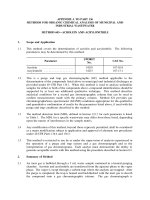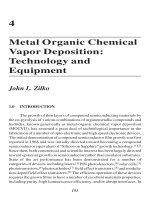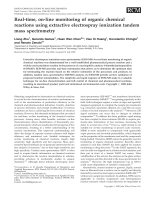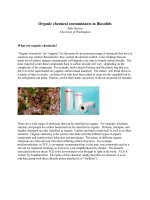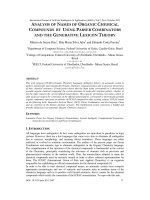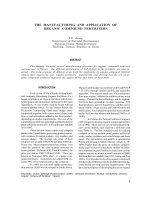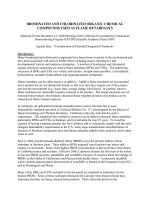ORGANIC CHEMICAL REACTIONS pot
Bạn đang xem bản rút gọn của tài liệu. Xem và tải ngay bản đầy đủ của tài liệu tại đây (409.05 KB, 10 trang )
UNESCO – EOLSS
SAMPLE CHAPTERS
ORGANIC AND BIOMOLECULAR CHEMISRTY - Vol. I - Organic Chemical Reactions - Alessandro Abbotto
©Encyclopedia of Life Support Systems (EOLSS)
ORGANIC CHEMICAL REACTIONS
Alessandro Abbotto
Department of Materials Science, University of Milano-Bicocca, Italy
Keywords: Synthesis, molecule, bond, molecular orbitals, charge, reactivity,
mechanism, functional groups, acids and bases, reactant, reagent, product, nucleophile,
electrophile, intermediate, transition state, regiochemistry, stereochemistry, carbocation,
carbanion, radical, equilibrium, equilibrium constant, cycle, heterocycle, aliphatic,
aromatic, arene, electron-withdrawing group, electron-donating group, leaving group,
kinetics, reaction order, reaction rate.
Content
1. Introduction
2. The Organic Reaction
2.1. Chemical Reaction Notation: Equilibrium Arrows. Reactants and Products
2.2. Mechanisms of Organic Reactions: The Arrow Notation
2.3. Thermodynamics and Kinetics: Reaction Equilibrium and Reaction Rate
2.4. Ionic Reactions
2.4.1. Nucleophiles and Electrophiles
2.5. Acids and Bases
2.5.1. Bröensted Theory
2.5.2. Lewis Theory
2.5.3. Hard and Soft Acids and Bases
2.6. Reactive Intermediates
2.7. Product Selectivity
3. Classification of Organic Reactions
3.1. Addition
3.1.1. Electrophilic Addition
3.1.2. Nucleophilic Addition
3.2. Elimination
3.3. Substitution
3.3.1. Aliphatic Nucleophilic Substitution
3.3.2. Aromatic Electrophilic Substitution
3.3.3. Aromatic Nucleophilic Substitution
3.4. Oxidation and Reduction
3.5 Rearrangements.
3.6. Pericyclic Reactions
Acknowledgments
Glossary
Bibliography
Biographical Sketch
Summary
Organic reactions have been used for preparing the huge amount of organic compounds
so far known and will be used for the synthesis of new organic molecules in the future.
UNESCO – EOLSS
SAMPLE CHAPTERS
ORGANIC AND BIOMOLECULAR CHEMISRTY - Vol. I - Organic Chemical Reactions - Alessandro Abbotto
©Encyclopedia of Life Support Systems (EOLSS)
A detailed knowledge of organic reactions and their mechanism is therefore an essential
tool for any scientist or technician involved with research and development of organic
molecules in any scientific and technological field. This chapter is divided into two
main parts. The first part introduces the reader to the basic and general knowledge of the
organic reaction, including the chemical notation, the mechanism, thermodynamics and
kinetics, a description of the main partners involved in the chemical transformation, and
an introduction to the main topics of organic chemistry strictly related to reactions and
reactivity. The second part is a description, organized by classes based on the
mechanism, of the most important and common organic reactions. Many examples are
given throughout the text with the help of a relevant number of figures. The person who
reads this contribution should be able to classify and understand virtually any important
organic reaction and gain the basics for organic synthesis research and development.
1. Introduction
Many millions of organic compounds are known today, either available in Nature
(natural products) or prepared by Man (synthesis products). Each of these molecules has
been obtained via a chemical reaction through the transformation of other organic
molecules. Consequently, many different organic reactions have been and are used by
scientists all over the world. During the XX century research has tremendously
improved the amount of organic reactions available to the scientist. Today, not only a
large variety of organic reactions is known but a detailed knowledge of their mechanism
has been disclosed to allow a precise control of the chemistry of the products. Luckily,
despite the large amount of known procedures, organic reactions present many
similarities among themselves, such as the type of mechanism or the chemical nature of
reactants and products. Thanks to these analogies, all of the organic reactions can be
classified within a relatively small number of classes. A few classification strategies
may exist, depending on the fact that the nature of mechanism, the structural change, or
the type of reactive functional groups is considered. We will follow here the criterion
based on the mechanism of the chemical transformation. A general section (Section 2)
will precede the description of reaction categories in order to provide the reader with the
basic knowledge and tools to understand, learn and apply the chemical reactions
classified in Section 3.
2. The Organic Reaction
2.1. Chemical Reaction Notation: Equilibrium Arrows. Reactants and Products
A chemical reaction is a transformation where one or more reactants are partially or
completely transformed into one or more products. According to the IUPAC
Compendium of Chemical Terminology a reactant is a chemical substance that is
consumed in the course of a chemical reaction, whereas a product is formed. The term
reagent, sometimes used as a synonym of reactant, is commonly referred to the partner
reagents which are added to the reaction mixture to bring about a reaction. In an organic
reaction the reactant(s) and the product(s) are organic while the reagents may be organic
or inorganic. Chemical reactions are commonly denoted as in Figure 1.
UNESCO – EOLSS
SAMPLE CHAPTERS
ORGANIC AND BIOMOLECULAR CHEMISRTY - Vol. I - Organic Chemical Reactions - Alessandro Abbotto
©Encyclopedia of Life Support Systems (EOLSS)
Figure 1: Commonly used symbolisms for organic chemical reactions. A) Generic
reaction. B) Reaction largely shifted towards the formation of the product(s). C)
Reaction mostly shifted towards the formation of the products. D) Reaction little shifted
towards the formation of the products.
All reactions are equilibria (Section 2.3.). The equilibrium concentration of all reagents
and products is determined by the reaction free energy and equilibrium constant. An
equilibrium reaction is a reversible transformation; a double arrow pointing to opposite
directions is inserted between reactants and products. However, many organic reactions
are almost completely shifted towards the products and the residual concentration of the
reactants at the end of the reaction is negligible. This happens when the equilibrium
constant is very high. For those reactions a single arrow may be used pointing to the
direction of the predominant species at the equilibrium.
It is worthy noting that in a chemical reaction one or more bonds are always broken
and/or formed and one or more atoms change their relative position. In a resonance (or
mesomerism) between two or more Lewis formulae (limit resonance structures) only
electrons move. A resonance is not a chemical transformation; all of the structures refer
to the same chemical species. In a resonance description a double-ended arrow is used
().
2.2. Mechanisms of Organic Reactions: The Arrow Notation
The symbolism shown in Figure 1 shows the chemical structures of the reactant(s) and
of the product(s) but does not give any information about the way the reaction proceeds.
More detailed information is given by the reaction mechanism. A mechanism is the
UNESCO – EOLSS
SAMPLE CHAPTERS
ORGANIC AND BIOMOLECULAR CHEMISRTY - Vol. I - Organic Chemical Reactions - Alessandro Abbotto
©Encyclopedia of Life Support Systems (EOLSS)
actual process of the chemical transformation. It shows how chemical species react and
how the products are formed, the motion of atoms and electrons from one species to the
other, which bonds are broken and formed, and the number of elementary steps
involved in the whole reaction. It gives you the structure of all the intermediates and
sometimes that of the transition states. A mechanism of a reaction must fit all the
experimental data, first of all the chemical nature of the formed products. The gross
mechanism of most common organic reactions is today known. However, many details
are still unknown, due to the large number of variables involved. For many reactions
even the gross mechanism has not been determined yet in an unambiguous manner and
two or more hypotheses may be present.
Figure 2: Curved arrows used for showing electrons motions in mechanisms. A) Motion
of an electron pair. B) Motion of a single electron.
Mechanisms show the motion of electrons involved in bond breaking and bond making.
These electrons are valence shell electrons and may be either bond or non-bond
electrons. Motion of electron is shown using curved arrows. Depending on the number
(either one or a pair) of electrons involved in a single motion, two types of curves have
been defined (Figure 2).
Mechanisms are extremely important in Organic Chemistry. If the mechanism is known
it is possible to predict the structures of the products, interpret the way a reaction
proceeds, or figure out why a reaction is not successful. The mechanism of a given
reaction is closely related to the chemical nature of the functional groups involved.
Therefore the mechanism is invariable for similar compounds and may be applied to a
potentially infinite number of chemical species with different substitution pattern far
from the reaction center. The reaction classification given in Section 3 is based on the
mechanism.
There are three types of mechanisms depending on the way bonds are broken and made:
• heterolytic
• homolytic
• pericyclic.
A general example of each type is depicted in Figure 3.
UNESCO – EOLSS
SAMPLE CHAPTERS
ORGANIC AND BIOMOLECULAR CHEMISRTY - Vol. I - Organic Chemical Reactions - Alessandro Abbotto
©Encyclopedia of Life Support Systems (EOLSS)
Figure 3: Reaction mechanism type depending on the nature of bond breaking and
making. A) Heterolytic. B) Homolytic. C) Pericyclic.
In heterolytic reactions the bonds are broken in such a way that the bond electron pair is
assigned completely to one fragment. These reactions are also called ionic reactions,
since ionic reactants, products, or intermediates are usually involved.
When the bond is broken in a homolytic manner one bond electron remains with one
fragment and the one bond electron with the other. Free radical intermediates are
therefore involved and these transformations are consequently called radical reactions.
Finally, a third type of organic reactions not belonging to any of the previous two
classes exists. No ionic or radical intermediates are formed during these
transformations. They proceed in one single concerted step, with no intermediates,
characterized by a cyclic transition state where bonds are simultaneously broken and
formed. Accordingly, it is improper to describe the mechanism by using a curved arrow
notation (Figure 2), though this representation is sometimes used for sake of
convenience. This mechanism is correctly pictured via interaction of frontier molecular
orbitals (FMO). Being cyclic transition states involved these reactions are called
pericyclic.
2.3. Thermodynamics and Kinetics: Reaction Equilibrium and Reaction Rate
When we look at an organic reaction (generally speaking, any chemical reaction) we
have to take into account two main concepts: the equilibrium and the rate of the
reaction.
The conversion between reactants and products is governed by the reaction free energy
ΔG, that is the difference between the free energy of the products and that of the
reactants. A reaction is thermodynamically allowed when the free energy of the
products is lower than that of the reactants, that is, ΔG is negative. When ΔG becomes
equal to zero the equilibrium is reached and an equilibrium constant K
eq
of the reaction
UNESCO – EOLSS
SAMPLE CHAPTERS
ORGANIC AND BIOMOLECULAR CHEMISRTY - Vol. I - Organic Chemical Reactions - Alessandro Abbotto
©Encyclopedia of Life Support Systems (EOLSS)
can be defined as a function of ΔG°, the variation in the standard free energies. The
equilibrium constant K
eq
is the ratio between the equilibrium concentration of the
products and that of the reactants. The free energy has two components, the enthalpy H
and the entropy S. Whereas ΔH of a reaction refer to the energy difference between the
products and the reactants, ΔS is related to the disorder of the reaction. When a reaction
equilibrium is studied, both factors must be taken into account. For instance, an
important gain in entropy occurs when the number of products molecules is larger than
that of the reactants.
A favorable thermodynamics is a necessary but not sufficient condition for a reaction to
take place. In fact, the equilibrium can be reached in a relatively fast or low manner. If
the rate is very low (for instance, months or even years or centuries) the net result is that
the reaction basically does not proceed, even if thermodynamically allowed. Both the
thermodynamics and kinetics must be favorable, that is the reaction must have a
negative ΔG and should occur in a relatively fast manner. As far as kinetics is concerned
the reactants must go through an energy barrier, called the free energy of activation
ΔG
‡
. Once this energy is gained, partial bond breaking and bond making takes place
giving a local high energy geometry, the transition state, which then evolves to the
intermediate/product. The lower is the free energy of activation, the faster is the
reaction.
All these concepts are conveniently depicted using energy vs. reaction profiles (Figure
4). The top profile is a one-step process, with no intermediates and one transition state
corresponding to the single step from reactants to products. The total variation in free
energy is negative (thus the reaction is thermodynamically possible). The shown free
energy of activation is the energy barrier from reactants to products. A corresponding
free energy of activation exists from the products to the reactants (not shown). The
bottom plot refers to a two-step reaction which proceeds though an intermediate species.
Each elementary step has its free energy of activation. In the example, the ΔG
1
‡
from
the reactants to the intermediate is larger than that (ΔG
2
‡
) from the intermediate to the
products. The first step is therefore kinetically more difficult than the second one and is
called the slow step, or rate-determining step, of the reaction. Indeed, the rate of this
step decides that of the whole process.
UNESCO – EOLSS
SAMPLE CHAPTERS
ORGANIC AND BIOMOLECULAR CHEMISRTY - Vol. I - Organic Chemical Reactions - Alessandro Abbotto
©Encyclopedia of Life Support Systems (EOLSS)
Figure 4: Energy vs reaction profiles for one- and two-step reactions.
In those reactions where two or more different products may be formed from the same
reactants, each process has its own energy/reaction profile. In general, the product with
the lower energy is associated to the transition state with the lower energy as well. The
formation of such product is thermodynamically and kinetically favored with respect to
the others. However, there are some cases where one product (e.g., A) has a lower
energy than a second product (e.g., B) but the transition state leading to A is less stable
UNESCO – EOLSS
SAMPLE CHAPTERS
ORGANIC AND BIOMOLECULAR CHEMISRTY - Vol. I - Organic Chemical Reactions - Alessandro Abbotto
©Encyclopedia of Life Support Systems (EOLSS)
than that leading to B. The formation of A is thermodynamically favored whereas the
formation of B is kinetically favored. The product A is called thermodynamically
controlled and B kinetically controlled (Figure 5). The preferential formation of A
rather than B, or vice versa, can be more or less successfully accomplished by running
the reaction under thermodynamic or kinetic control, respectively. In the former case,
the reaction is carried out at higher temperatures so to level off any kinetic deviation
and allow the equilibrium to be established. The most stable product (A) will then be
preferentially obtained. In the latter case the reaction is usually performed at low
temperatures, so to maximize rate differences and stop the process well before the
equilibrium is reached. The product with the lower energy of activation (B) will be
preferentially formed.
Figure 5: Thermodynamic and kinetic control: energy vs. reaction profiles.
Figure 6 shows an example of thermodynamically and kinetically controlled products.
At lower temperatures the sulfonation of naphthalene (see: aromatic electrophilic
substitution, Section 3.3.2.) gives the -isomer, being the position the most reactive
site of naphthalene in the aromatic electrophilic substitution. However, this isomer is
less stable than the isomer because of steric interaction between the SO
3
H group and
the hydrogen atom at the position 8. Therefore the isomer predominates at higher
temperatures, under thermodynamically controlled conditions.
UNESCO – EOLSS
SAMPLE CHAPTERS
ORGANIC AND BIOMOLECULAR CHEMISRTY - Vol. I - Organic Chemical Reactions - Alessandro Abbotto
©Encyclopedia of Life Support Systems (EOLSS)
Figure 6: An example of thermodynamically and kinetically controlled products.
-
-
-
TO ACCESS ALL THE 55 PAGES OF THIS CHAPTER,
Visit:
Bibliography
McNaught, A. D., Wilkinson, A.(1997). IUPAC - Compendium of Chemical Terminology, The Gold
Book, 2
nd
edition; Blackwell Science, 1997; also available online at [This is the
official book by IUPAC on chemical terminology. It collects together terminology definitions from
IUPAC recommendations. The online version mostly corresponds to the second edition published in print
form in 1997]
Smith, M. B., March, J. (2001). March’s Advanced Organic Chemistry, 5
th
edition. New York: Wiley
[This is one of the most comprehensive texts in essential and advanced organic chemistry. It is an
important tool for experts and non-experts in the field]
Carey, F. A., Sundberg, R. J., (2000). Advanced Organic Chemistry, 4
th
edition; New York: Kluwer
Academic – Plenum Publishers [This is a two-volume comprehensive textbook on advanced organic
chemistry. The first volume focusses on structures and mechanisms. The second volume deals with
organic reactions and syntheses]
Fieser, L. F.; Fieser, M. (1967-2005). Fiesers' Reagents for Organic Synthesis. New York: Wiley [This is
one of the most comprehensive compendia on organic reagents and their use in organic reactions]
Freeman, J. P. (1966-2004). Organic Syntheses – Collective Volumes. New York: Wiley [This is the most
detailed collection of organic reactions. It collects hundreds of checked experimental procedures for the
synthesis of organic compounds including full experimental details, notes, and suggestions].
UNESCO – EOLSS
SAMPLE CHAPTERS
ORGANIC AND BIOMOLECULAR CHEMISRTY - Vol. I - Organic Chemical Reactions - Alessandro Abbotto
©Encyclopedia of Life Support Systems (EOLSS)
Streitwieser, A., Heathcock, C. H., Kosower, E. M. (1992). Introduction to Organic Chemistry, 4th
Edition, Prentice Hall MacMillan. [This is a university textbook for organic chemistry first-users. It gives
a rather thorough introduction to all of the major fields, compounds and reactions, of organic chemistry]
Biographical Sketch
Abbotto, Alessandro was born in Milan in 1963, graduated in Chemistry from the University of Milan in
1989 (with honors). In 1990 he was awarded a prize (Dow Italy) for best student in Chemistry and
Industrial Chemistry of the University of Milan. Graduate student from 1990 to 1993, receiving his Ph.D.
in Chemistry from University of Milan (Mentor: Prof. G. A. Pagani). He worked at the University of
Berkeley, CA (USA) (Mentor: Prof. Andrew Streitwieser) as a post-doctoral fellow (NSF funding) in
1994- 1995 and then at the University of Erlangen-Nuernberg, Erlangen (D) (Mentor: Prof. Paul v. R.
Schleyer) with a NATO fellowship in 1995. He joined the Materials Science Faculty of the University of
Milan in December 1995 as Assistant Professor in Organic Chemistry. In 1998 he moved to the
University of Milano-Bicocca where he got an Associate Professor position in Organic Chemistry in
2001. Co-author of a university textbook in Heterocyclic Chemistry, ca. 80 papers in international
scientific journals including 3 international patents, 11 invited lectures and ca. 100 communications at
national and international meetings. Member of the Scientific Board of CMG (University of Milano
Bicocca - Sapio Industrie network); application reviewer for national and international funding agencies
(I-MIUR, I-INSTM, USA-NSF, CAN-CFI Canada Foundation for Innovation). Peer reviewer for many
ACS, Wiley-VCH and other journals. Current scientific interests involve design, synthesis and
characterization of organic and organometallic materials (including 1D-3D polar organic chromophores
for nonlinear optics and multiphotonics, ion-templating multidimensional hybrid NLO-phores, multi-
branched systems, hybrid organic-inorganic/metallic materials) for advanced applications in opto-
electronics and (nano)photonics.


